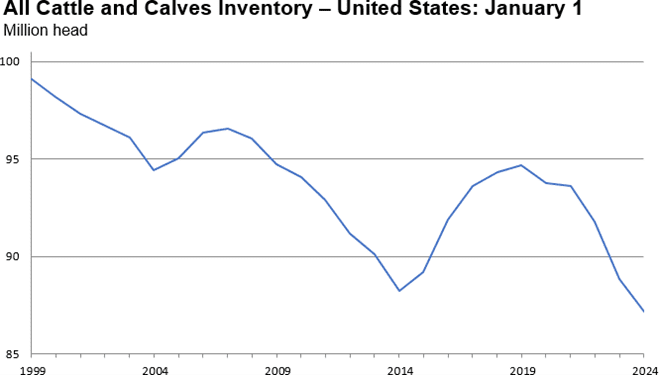HAMMERED by drought for the past two years, the United States beef cattle herd has now fallen to levels not seen since 1951, an important annual US Department of Agriculture survey has found.
The annual cattle report issued overnight by USDA’s National Agricultural Statistics Service shows there were 87.2 million head of cattle and calves on US farms as of January 1, the lowest level in 73 years (see graph).
The findings have large implications for the Australian export beef industry, both in terms of prospects for greater exports into the US in coming years, and competition in markets like Japan, Korea and China where the US and Australian beef industries compete head-to-head.
What has surprised many in the Australian beef industry is how long beef production levels in the US have remained high, despite the prolonged drought impact on herd numbers.
Other key results from the report:
- Of the 87.2 million head inventory, all cows and heifers that have calved totalled 37.6 million
- Beef cow numbers totalled 28.2 million on January 1, down 2pc or 700,000 head from the previous year
- The US calf crop was estimated at 33.6 million, down 2.5pc from an already reduced 2022
- All cattle on feed were at 14.4 million head, up 2pc from 2023.
Heifer numbers held for beef cow replacement continued to decline, and substantial revisions were made in this week’s report to last year’s figures.
Analyst Len Steiner from Steiner Consulting said implications from the smaller calf crop implied smaller US slaughter next year.
“High heifer slaughter of the last couple of years has altered the relationship between calf crop and federally inspected US slaughter,” Mr Steiner said.
He said the NASS report was in-line with pre-report expectations, with most categories below a year ago.
“Heifer replacements are providing some interesting insights into cow-calf producers’ sentiment. Total beef cow replacements were down 1.4pc from last year, but last year’s numbers were moved lower,” Mr Steiner said.
However last year’s January 1 report had beef cow replacements at 5.164 million head, a staggering 6pc drop from the year before. The latest report published overnight reported a revision on those figures, lowering the number to 4.93 million head and making the total percent change from 2022 to 2023 down 10pc, he said.
“State-level data showed few US states held enough optimism to retain more than a handful of heifers in 2023.”
While 15 US states did increase, any gains were small.

Len Steiner
Lower replacements and a smaller calf crop this year implied further declines in slaughter to come. Although not perfect, typically the offset in slaughter was lagged one to two years after calf crop changes, Mr Steiner said.
“More recently, slaughter has seen higher numbers remain even as calf crops have declined for the last five years. Heifer slaughter has been substantially higher during these times, mitigating at least some of the declines in the calf crop,” he said.
“But this phenomenon cannot continue indefinitely, as the cow herd will need to refresh.”
Mr Steiner anticipates that within the next couple of years, US slaughter levels will dip substantially, as they did in 2015, following the previous US drought cycle.
Two recent US beef production forecasts – the January World Agricultural Supply and Demand Estimates, and the Livestock Market Intelligence Service report – had US beef production (fed and unfed) down 3pc and 5.3pc, respectively. Both forecasting groups attributed higher carcase weights to the relatively modest decline in production. The year after – 2025 – may be when the big herd impact shadow is felt in US production.
About the NASS survey:
Each January, the USDA’s National Agricultural Statistics Service carries out a comprehensive survey of US cattle numbers, pegged to 1 January. This year, NASS surveyed an enormous 36,300 US cattle operators across the nation (face-to-face, telephone and email) during the first half of January. Surveyed producers were asked to report their cattle inventories as of January 1, 2024, and calf crop for the entire year of 2023.

